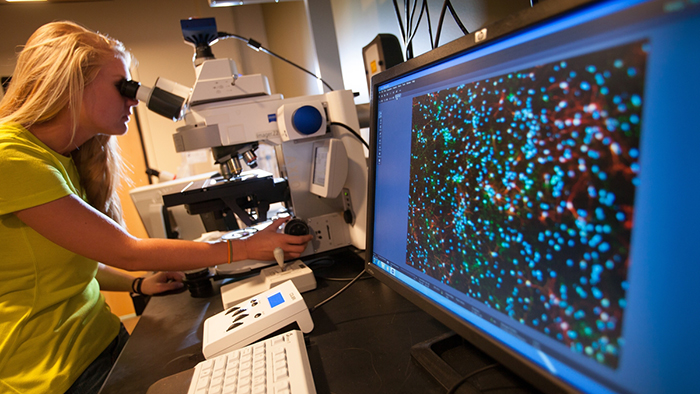 “Grandma always says, ‘Have chicken noodle soup when you’re sick,’” said Jordan Hawkins, senior research scientist at Missouri State University’s Center for Biomedical and Life Sciences.
“Grandma always says, ‘Have chicken noodle soup when you’re sick,’” said Jordan Hawkins, senior research scientist at Missouri State University’s Center for Biomedical and Life Sciences.
Along with Dr. Paul Durham, distinguished professor of biology and director of the CBLS in the Jordan Valley Innovation Center, she is conducting research on International Dehydrated Foods’ chicken broth products and their relationship to inflammation and pain. This research has been funded by several grants from IDF totaling more than $100,000.
Audio Player
Chicken soup reduces inflammation
“It’s strange that throughout all the different cultures, these different broth products are almost used as medicinal,” said Hawkins.

Testing IDF’s broth against others on the market as well as several homemade broths, they realized the IDF composition was superior in reducing pain and inflammation by decreasing levels of the pro-inflammatory protein PKA. The exact mechanism is still a line of investigation in the lab.
Hawkins believes that the patented process by which IDF prepares their broth makes available more of the nutrients, which helps the body absorb and utilize the beneficial molecules to promote health.
“We actually showed that by eating approximately one bowl of chicken soup per day of their product was sufficient to inhibit the development of chronic pain in the head and face,” stated Hawkins.
They also discovered that consuming chicken broth changes the gut microbiome in a manner similar to ingesting a prebiotic like yogurt, and thus may be helpful in the treatment of IBS or irritable bowel syndrome.
Pungent odor triggers migraine
Much of the work conducted in the CBLS laboratory relates to chronic pain, especially in the orofacial region. They search to identify risk factors and triggers of migraine attacks and temporomandibular disorders (TMD) pain, and also research ways to inhibit the neurological pathways to block the pain.
They’ve found that having neck and shoulder tenderness and pain caused by muscle inflammation can act as a risk factor to cause sensitization (a lowering of the activation threshold) of trigeminal nerves, which are the nerves involved in the pain of migraine and TMD.

The Durham lab has discovered that when trigeminal nerves are in a sensitized state, as is commonly reported by migraine and TMD patients, they can be triggered or activated by strong odors.
A trigger migraineurs routinely cite is pungent odors such as strong perfume and many spices, so Hawkins has conducted some studies on the California Bay Leaf.
“It’s also nicknamed the headache tree because when the wind blows, individuals susceptible to migraines are likely to experience one,” she said.
Vagus nerve stimulation
One way pain is abated is through massage or stimulation. Through a $10,000 grant from electroCore, Hawkins and Durham have been studying the effectiveness of electroCore transdermal vagus nerve stimulation. More than anything, they say they are attempting to tease out where in the pain pathways it works and how.
The vagus nerve, which is located near your carotid artery, regulates heart rate and the function of the digestive tract, as well as having a role in pain modulation.
“The advantage of this technology is that it provides a non-invasive method to block the pain pathways activated during a migraine attack and thus others a non-pharmacological means to help manage migraine,” added Durham.

